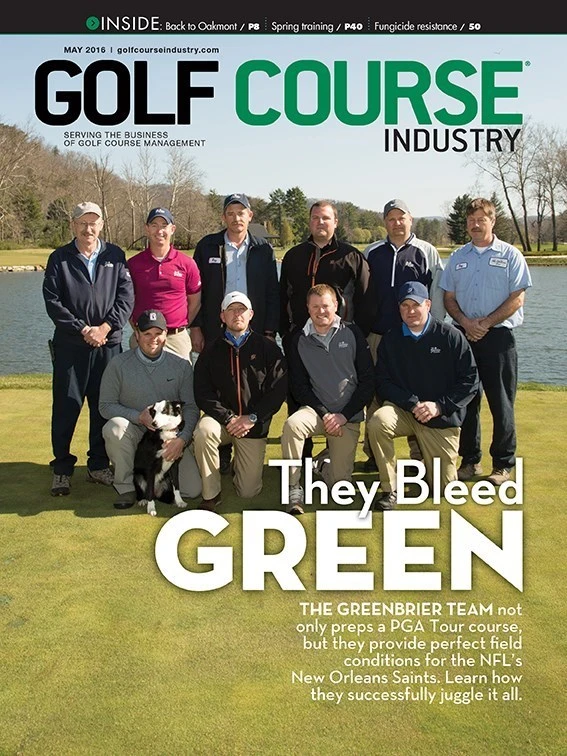To understand the role golf course maintenance plays at a resort, often you are diverted from the original purpose of your trip. You visit a wedding chapel that looks 125 years old only to be informed it opened last year, eat a bowl of peach soup and discuss clay court maneuvers with a tennis pro, and limited time at a fascinating place drifts away quicker than a ball landing on the wrong side of Oakmont’s greens.
Completing this month’s cover story required a visit to The Greenbrier, a West Virginia resort with a bunker that was built as a Cold War shelter for Congress and enough activities to occupy politician’s families when they visit. PGA Tour players, high-rolling golf savants willing to drop $300 to roam pristine turf and even NFL players visit The Greenbrier, which rests between Beckley, W.Va., and Roanoke, Va. I consider the resort’s location one of the most scenic places you can possibly build golf courses – or football fields.
Before committing to the story, I asked numerous industry contacts what they knew about The Greenbrier and its maintenance practices. Did anybody in our industry realize a crew in southern West Virginia was maintaining turf for PGA Tour and NFL players? Fortunately for the sake of producing a cover story with broad appeal, little awareness of The Greenbrier’s turf activities existed outside a pocket of Mid-Atlantic superintendents and suppliers.
The New Orleans Saints – a team that wears black and gold and boasts a future Hall of Fame quarterback – moved their training camp to The Greenbrier in 2014. The move was announced before the resort had completed its two grass and one synthetic practice fields. The pressures facing director of golf course Kelly Shumate and his staff are described in the story.
The arrival of the Saints represented a tremendous diversion for a crew already moving in numerous directions. It also represented an opportunity to showcase turf knowledge in new ways. The Greenbrier isn’t the first place to maintain golf courses and athletic fields. Think of all the municipalities offering both amenities to residents. But we’re guessing Bubba Watson isn’t smashing 330-yard drives and Drew Brees isn’t planting his feet and zipping darts on your town’s turf.
The arrival of the Saints represented a tremendous diversion for a crew already moving in numerous directions. It also represented an opportunity to showcase turf knowledge in new ways.”
The Greenbrier’s story is impressive because it handled most of the heavy lifting internally. Shumate and his team quickly discovered turf skills acquired through maintaining golf courses apply to sports turf. Carrington Bryant, a young, energetic presence on Shumate’s crew, oversees the maintenance of the fields. Bryant took classes in golf and sports at Horry Georgetown Technical College. He arrived at The Greenbrier as an assistant superintendent. His turf knowledge and zest for football convinced Shumate he didn’t need to look for an outsider to maintain the fields.
“Your basic agronomy is going to be the same,” Bryant says. “Drainage, irrigation are all the same. Playing conditions are a little bit different. Golf is all about firm and fast. A football field is maybe not as firm and fast as you want a putting green to be. Other than that, they are both very detail-oriented in their own little ways.”
A day maintaining a field for NFL players begins with removing the dew from the field around 6:30 a.m. Bryant and his crew, which consists of two members of the turf team, fill divots between whistles and snaps during morning practices. More divots are filled and debris is blown off the fields during breaks. Mowing the 3.88 acres of Kentucky bluegrass takes 1 hour, 15 minutes and occurs between morning and afternoon practices five or six times per week.
The most perplexing part of adjusting to sports turf, according to Bryant, is learning how to properly paint fields. In short, it’s much more intricate than painting any part of a golf course. “Painting out of bounds markers doesn’t prepare you for it,” Bryant says.
Cultural practices such as verticutting and topdressing are more frequent and intense and mowing heights are much lower on a golf course, Shumate says. Saints coach Sean Payton and facilities directors Terry Ashburn provide input on the height of cut, which is slightly below an inch. When the PGA Tour and Saints aren’t in town, the fields are easier to maintain because they receive less use, allowing Shumate and Bryant more flexibility in maintenance practices and staffing.
Expectations are similar. If the turf doesn’t hold steady during those key summer weeks, fewer people want to conduct weddings in the chapel or eat the peach soup. Whether it’s a golf course or football field, The Greenbrier proves tremendous turf adds value to other diversions.
Get curated news on YOUR industry.
Enter your email to receive our newsletters.
Explore the May 2016 Issue
Check out more from this issue and find your next story to read.
Latest from Golf Course Industry
- GCSAA’s Health in Action 5K/2K reaches fundraising goal
- Landscapes Golf Management to participate in data analyzation initiative
- Reel Turf Techs: Carl Michael
- Atlanta Athletic Club approves funding for master plan
- Maximizing Cultural Practices and Agronomic Benefits with Minimal Surface Disruption
- Real Answers about Spray Nozzle Choices
- From the Course to the Factory: How Customer Insights Drive Innovation
- New & Proven Enzyme Strategies for Sprayable Thatch Management







